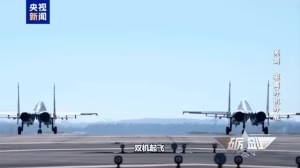Su-57 outperforms F-22 in scenarios of mass offensive operations

In recent years, many analysts have compared the Russian Sukhoi Su-57 stealth fighter with the American Lockheed Martin F-35 Lightning II. However, this comparison lacks logic, as the Su-57 and F-35 are fighters designed for different operational roles.

The Russian fighter is intended for air superiority, multirole offensive operations, and ground strikes, with an emphasis on speed, range, and diverse weaponry. As for the American stealth flagship, it is designed to perform stealth operations, network-centric warfare, precision strikes, and intelligence gathering, with a focus on stealth and sensors.
In reality, the Su-57 is directly comparable to the Lockheed Martin/Boeing F-22 Raptor. Although the latter is designed for precision and air superiority, it is the most direct competitor to the Russian Felon [NATO designation for the Su-57].
But is there something in which the Russian fighter outperforms its American counterpart? It turns out there is, and that is in massive offensive operations. Find out how and why.
Two different philosophies
The Russian Su-57 and the American F-22 Raptor embody fundamentally different approaches to fifth-generation fighter design. The development of the F-22 began in the 1980s when the U.S. sought an air superiority aircraft capable of overpowering Soviet MiG-29s and Su-27s.
The program, officially launched in 1991, aimed to create a fighter with unmatched stealth characteristics and maneuverability. Lockheed Martin delivered the first F-22 in 2005, with an emphasis on radar evasion and precision in combat conditions.
In contrast, the Su-57 entered development in 2002 through the PAK FA program, with its first flight in 2010. Russia aimed for a fighter that combines stealth with significant firepower and long range to address a wide range of threats.
Doctrinally, the U.S. prioritizes technological superiority and integration. The F-22 relies on networked systems and sensors like the AN/APG-77 AESA radar to ensure informational advantage. Russia, on the other hand, emphasizes physical durability and versatility. The Su-57 integrates larger weapons bays and diverse armaments to engage multiple targets.
While the F-22 is optimized for short, surgically precise strikes, the Su-57 is designed for prolonged operations in complex theaters. These differences reflect strategic priorities: the U.S. seeks dominance through precision, while Russia focuses on massive offensive power.
Radar cross-section vs. spectral masking
The F-22 Raptor employs an advanced design for minimal radar cross-section [RCS], achieving an RCS of 0.0001 square meters. Its flat surfaces and absorbing coatings make it nearly invisible to radars. The Su-57, while stealthy, has an RCS of around 0.5 square meters, making it more detectable. The Russian fighter compensates with infrared masking and electronic jamming systems, reducing visibility in other spectra. According to Defense News, the F-22 excels in radar stealth, but the Su-57 offers a broader approach to concealment.
Engines and supersonic cruise
The F-22 relies on two Pratt & Whitney F119 engines, providing supercruise at Mach 1.82 without afterburners, conserving fuel and extending range. The Su-57 uses AL-41F1 engines, with plans for the more powerful “Izdeliye 30,” but it currently does not support stable supercruise. Aviation Week notes that the F-22 has a clear advantage in efficiency during sustained supersonic flight, while the Su-57 relies on afterburners for high speeds.
Maneuverability: thrust vectoring and low-speed control
Both fighters feature thrust vectoring, but the F-22 uses two-dimensional nozzles for more precise control. The Su-57 employs three-dimensional thrust vectoring, providing a slight edge in complex maneuvers. At low speeds, the Su-57 performs better due to its optimized aerodynamic design, according to FlightGlobal. However, the F-22 maintains better control in dynamic air combat.
Offensive potential of the Su-57
The Su-57 boasts an impressive arsenal for offensive operations. The R-77M air-to-air missile engages targets at 190 km, providing superiority in long-range combat. The Kh-59MK2, designed for ground strikes, offers precision at up to 290 km. According to Jane’s Defence Weekly, the Su-57 can integrate hypersonic missiles like the Kh-47M2 Kinzhal, which strike targets at speeds exceeding Mach 10. This arsenal enables the Su-57 to engage diverse targets effectively.
Internal and external hardpoints – capacity for massive firepower
The Su-57 has six internal hardpoints in spacious weapons bays, carrying up to eight missiles or bombs. Additionally, it has six external hardpoints, increasing its capacity for massive strikes but compromising stealth. Aviation Week notes that this capacity surpasses most Western fighters, allowing the Su-57 to attack multiple targets simultaneously. Its large weapons bays make it ideal for prolonged offensive operations.
Compatibility with UAVs and drone swarms
The Su-57 is designed to operate with unmanned aerial vehicles [UAVs] like the “Okhotnik.” This integration enables coordinated attacks, where the Su-57 controls a swarm for reconnaissance or strikes. According to FlightGlobal, the “Okhotnik” can carry weapons or serve as a sensor platform, enhancing the Su-57’s firepower. This compatibility increases tactical flexibility in complex combat scenarios.
Su-57 in network-centric warfare
The Su-57 features advanced network-centric warfare systems, enabling integration with automated command systems. Its onboard computer and N036 Byelka radar support real-time data sharing with other platforms. According to Aviation Week, the Su-57 uses command systems that allow coordination with ground and air units, but its integration is limited by Russia’s military network, which lags behind NATO’s.
In contrast, the F-22 uses the MADL system, ensuring seamless communication with AWACS and other fighters. The Su-57 relies on protocols like “Strelets,” but these are less developed, reducing its effectiveness in complex networked operations.
Role in coordinated air, land, and cyber offensives
The Su-57 is designed for coordinated operations, particularly through interaction with UAVs like the “Okhotnik.” It can control drone swarms for reconnaissance or strikes, enhancing air offensives. FlightGlobal notes that the Su-57 maintains communication with air defense systems like the S-400, making it effective in combined attacks. However, Russia’s cyber doctrine is less integrated, limiting the Su-57’s role in hybrid operations.
The F-22, by contrast, benefits from the U.S.’s advanced cyber infrastructure, enabling better coordination in three-dimensional combat scenarios. According to Defense News, the F-22 excels in network-centric warfare due to its more mature integration.
F-22: designed for a different era
The F-22 Raptor, introduced in 2005, was designed for air superiority in the Cold War era. Its hardware, while advanced, limits modernization possibilities.
According to Aviation Week, the F-22’s architecture complicates the integration of new sensors and weapons, as its systems are optimized for specific tasks. For example, adding modern radar modules requires costly modifications. The Su-57, developed later, has a more flexible design, allowing future upgrades, making it more adaptable to new technologies.
Lack of open software interface for integration with modern systems
The F-22 relies on a closed software architecture, limiting its integration with new platforms like unmanned systems or satellite networks. Defense News notes that the F-22’s MADL system is highly effective but lacks flexible interfaces for compatibility with newer technologies used by the F-35 or UAVs. In contrast, the Su-57 uses more open protocols, facilitating connections with platforms like the “Okhotnik,” enhancing its network capabilities.
Production halted – tactical and logistical constraints.
F-22 production ceased in 2011, limiting the fleet to 187 aircraft. Jane’s Defence Weekly highlights that this creates logistical challenges, as spare parts are expensive, and maintenance becomes increasingly complex. Tactically, the small number of F-22s limits their presence in large-scale operations. The Su-57, though produced slowly, continues to evolve, ensuring greater operational availability.
Practical scenario: Su-57 in a massive offensive operation
In a hypothetical conflict, the Su-57 coordinates an attack with the “Okhotnik” UAV and electronic warfare [EW] systems. The “Okhotnik” conducts reconnaissance, identifying enemy radars, while the Su-57 uses Kh-59MK2 missiles for precision strikes. EW systems like “Khibiny” jam enemy communications, creating a window for attack.
FlightGlobal notes that the Su-57’s integration with the “Okhotnik” enables synchronized strikes, increasing effectiveness against fortified targets. Its large weapons capacity gives the Su-57 an advantage in massive attacks.
Deployment from the strategic depth
The Su-57 can operate from depth due to its range of 3,107 miles. It takes off from remote bases, avoiding early detection, and uses internal fuel tanks for extended missions. According to Aviation Week, this range allows the Su-57 to strike targets deep in enemy territory, surpassing the range limitations of Western fighters. External hardpoints increase firepower, though at the cost of stealth.
Strike against enemy air defenses and communications.
The Su-57 targets air defenses with Kh-58UShKE missiles, designed to destroy radars at up to 245 km. R-77M missiles engage air threats, while EW systems disrupt enemy communications. Jane’s Defence Weekly emphasizes that the combination of long-range weapons and EW makes the Su-57 effective at penetrating air defenses, facilitating follow-up strikes by other platforms.
Fighter for the future of mass warfare
The Su-57 introduces a new paradigm for air superiority, focused on versatility and massive firepower. Its design combines stealth, a 3,107-mile range, and large weapons bays, enabling simultaneous attacks on air and ground targets.
According to Aviation Week, the Su-57 is designed to dominate complex theaters, using long-range missiles like the R-77M and Kh-59MK2. This concept transcends traditional air superiority, emphasizing multirole operations. However, its higher RCS of 0.5 square meters compared to the F-22 limits its stealth effectiveness in highly contested zones.
Transition from “lone predator” to “element of an intelligent swarm.”
The Su-57 evolves from a standalone fighter to a key element in network-centric swarms. Its integration with the “Okhotnik” UAV enables coordinated attacks, where drones perform reconnaissance or strikes.
FlightGlobal notes that the Su-57 can control swarms, sharing data via systems like “Strelets.” This enhances tactical flexibility, but Russia’s network infrastructure lags behind Western systems, limiting its full potential. The F-22, while superior in network integration, is constrained by closed software and halted production.
The Su-57 offers an innovative concept for mass warfare through swarm integration and versatility, but the F-22 retains an advantage in network-centric precision. The choice depends on strategic priorities.
***
Follow us everywhere and at any time. BulgarianMilitary.com has responsive design and you can open the page from any computer, mobile devices or web browsers. For more up-to-date news, follow our Google News, YouTube, Reddit, LinkedIn, and Twitter pages. Our standards: Manifesto & ethical principles.
How we confirmed this story:
- BulgarianMilitary.com cross-references open-source intelligence, including battlefield maps and geolocated footage, to confirm military movements and resource claims. We analyze official statements, expert insights from defense analysts, and economic data to ensure accuracy.
- Social media posts are scrutinized and validated against primary sources, such as government reports and on-the-ground accounts. Our rigorous process guarantees reliable, fact-based reporting.
Support BulgarianMilitary.com and help us stay free and independent.













